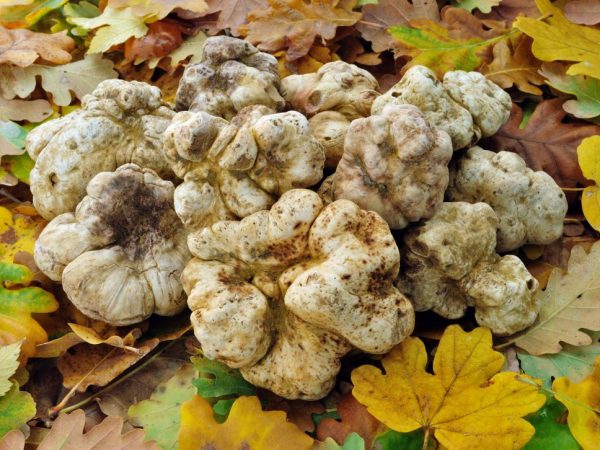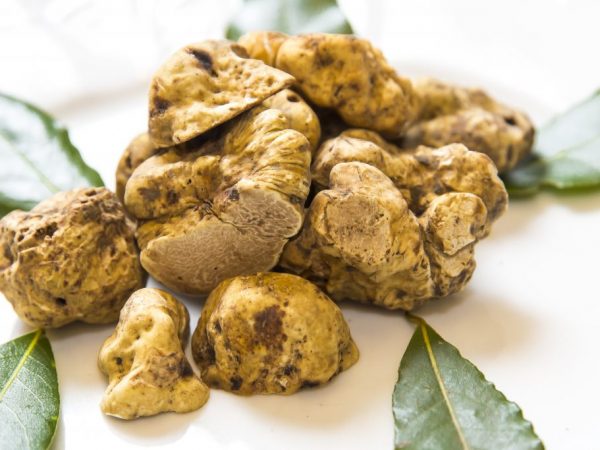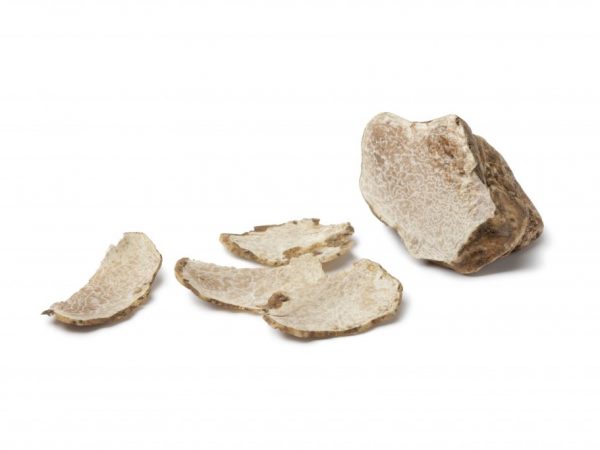Features of the white truffle
One of the representatives of mushrooms, at first glance, unattractive, but valuable in their taste, is the white truffle.

Features of White Truffle
Description of appearance
The white truffle belongs to the department Ascomycetes, or Marsupials, of the Peziziales order, the Truffle family. The mycelium of the fungus develops underground.
Description of white truffle:
- the body is fleshy;
- shape in the form of a potato tuber, irregular;
- the surface is smooth or wrinkled;
- surface color white-yellow;
- does not have a leg and a cap
- size - up to 13 cm;
- spores in the form of a ball with processes.
The white truffle differs from its usual (hat-toed representatives of the kingdom) counterparts. It does not have clearly defined legs and caps. Its fruiting body (apothecia) changes color depending on age. It is round, smooth at a young age. The older the truffle, the more "wrinkles" appear on the surface. The hue ranges from light white to reddish.
The potato-like tuber grows in the top layer of the soil. A small upper part is visible above its surface.
Varieties
White truffle has an exquisite taste and aroma. In the process of growth, it forms a kind of symbiosis (mycorrhiza) with coniferous or deciduous trees.
There are several varieties of white truffles:
- Piedmontese (Tuber magnatum);
- March (Tuber borchii, Tuber albidum);
- Duronsky (Tuber excavatum);
- Variegated (Tuber maculatum);
- Moroccan (Tuber oligospermum);
- Oegon spring (Tubergibbosum).
Truffle white Piedmontese (Italian): this species grows in southern Europe. Fruiting from early October until the end of November. If the weather permits, until January it is found under deciduous or coniferous trees. Its size reaches a volume of 12-15 cm with a weight of 20 g to 1 kg 125 g. The aroma is strong, characteristic (the smell of cheese with garlic). The white Piedmontese truffle is considered the most valuable of all known types. It does not grow in the Moscow region.
White March truffle: this species is considered European. Symbiotic relationships are formed with deciduous trees, in rare cases with conifers. It is small in size, up to 7 cm in diameter, and weighs from 25 g to 260 g. The taste and smell are subtle. Not particularly valuable in cooking. Known in Crimea. The color changes with the age of the fungus. Young specimens are whitish, then beige and red-brownish at the end. Favorable time for collection is the end of February and March. By the way. With age, the pleasant smell of the truffle is modified and becomes repulsive.
White Duronsky truffle: grows everywhere in Russia and Europe. It thrives on deciduous or coniferous species from September to December. Its size is up to 4 cm, weight is up to 70-80 g. The aroma is interesting, sweetish-spicy, the pulp is dense. In Europe, it is collected independently, but not very often.

There are several types of truffles
White variegated truffle: grows both in Europe and in Russia in conifers (including those with fir) or deciduous forests.Mass collection takes place from June to early September. The sizes are small, up to 1-2 cm and very rarely up to 7 cm. The usual weight of apothecia is 5-20 g and rarely up to 200. The aroma is refined, pleasant. On the basis of the pulp of representatives of this species, they make a delicious strong-smelling oil for flavoring dishes.
White Moroccan truffle: recorded in North America, in oak, pine and cedar groves. Mass collection takes place in a short period of time (May-June). Not of interest for the restaurant business. This variety is characterized by a pleasant sweetish nutty aroma. Small size - 2.5-5.5 cm, weight - up to 130 g.
Oregon Spring Truffle: rarely found in North America (in the northwest), in Canada. It does not grow on the territory of Russia. Fruiting from March to May, in rare cases - to June. It looks neat, has a size of 1.5-5 cm. Weight - from 4 to 200 g. It has a pleasant aroma with a slight hint of spices. The smaller the mushroom, the more expensive it is. It is massively harvested and used in cooking.
Irina Selyutina (Biologist):
On the territory of the Russian Federation, the type of truffle is widespread Truffle white (Choiromyces meandriformis), which has names of synonyms - Polish truffle, Troitsky truffle. Despite the Russian-language name "truffle", this species does not belong to the genus Tuber, like real truffles, but to the genus Choiromyces from the same Truffle family (Tuberaceae). This species does not have the same value as real truffles. It grows in several types of forests - coniferous and deciduous. In coniferous forests, it can be found among young pines, and in deciduous forests, it can be found next to birches, aspens, or in hazel trees. The fruit body is located in sandy or clay soil at a depth of no more than 8-10 cm, and sometimes a kind of tubercle without vegetation forms on the soil surface. Has a strong odor. It does not occur annually.
This species belongs to the 4 taste category. It is noted that this type of mushroom is characterized by a meat rather than a mushroom taste.
In the Kostroma region, this species is known as "cow bread".
Truffle mycelium of any kind usually gives rise to 3-7 fruiting bodies, which are arranged in a circle and form a "nest". These places among the collectors were called "truffle".
It takes 3-4 months for a truffle to fully develop.
Beneficial features
Truffles are fragrant and tasty mushrooms, but they cannot be stored for a long time. During the harvest season, they are eaten raw. White and black truffles are bought by elite restaurants in small quantities. The larger the fruiting body, the more expensive it is.
These mushrooms are saturated with vitamins C, PP, B1 and B2, proteins and useful carbohydrates. When eaten, the pheromones in their composition lift the mood. Antioxidants improve blood composition.
White truffle juice is used to treat glaucoma and other eye diseases. With gout, regular consumption of mushrooms leads to long-term remission or complete recovery.
Contraindications
The harm from eating them has not been noted by official science.
You can not eat them for people with individual intolerance or prone to allergic reactions. Pregnant women and children should be approached with caution for food or medicinal purposes, only after consulting a doctor.
Application
Truffles are used in medicine, cooking and cosmetology.
Cooking applications
These mushrooms are purchased in small batches and stored in tightly closed containers, covered with olive oil or covered with rice grains. If you have to use it for a longer period, it is shockingly frozen.
Irina Selyutina (Biologist):
If you happen to become a happy owner of truffles while picking mushrooms, they will help diversify your table. And in order not to spoil such an expensive mushroom, it is important for you:
- remove all soil from the surface of the truffle and wash it thoroughly just before eating. It is necessary to clean the mushroom perfectly, because you only need to cut it with a shell;
- after washing, dry the fruit body with a paper towel;
- for slicing, the so-called. truffle slicer. You can take an ordinary knife, but the slices should be very thin.
With thin slices of truffle or its shavings, it is recommended to season pasta, soufflé, rice, veal, omelettes, fish or chicken.
To prepare a dish, to give it a special and unique aroma, only 8 g of the product is enough. A black or white truffle is often added to the main ingredient. It is cut on a special grater adapted only for this. In elite restaurants, a specially trained chef is involved in the cutting process, who does it by hand with his knife.

Mushrooms are appreciated by chefs
The French add truffles to sauces, poultry and seafood dishes, fruits and eggs. In its pure form, rich people can afford it. To emphasize the taste, the product is served with wine or cream sauce.
In pies, the filling becomes tastier and more aromatic if you put a few small pieces of this delicacy. It is used to decorate exotic dishes, with snails, black or red caviar.
Application in cosmetology and medicine
In medicine, white truffles are rarely used: it is too expensive an ingredient for mass production of medicines. On individual orders, they make a tincture for pancreatitis and ointments to improve blood circulation (with varicose veins). In the countries of the East, truffle juice is used for medicinal purposes (but again, very rich people). You can also order truffle juice online, but it must be a trusted source so that the buyer does not fall victim to scammers.
In cosmetology, they are used as one of the components of face creams. Truffle ingredients tighten wrinkles, reduce pigmentation and improve skin tone.
Growing methods
The cost of this mushroom is over 1000 USD per 1 kg. They are trying to grow it at home.
In France, truffle cultivation began in 1806, when oaks were planted, under which the first harvest of a delicious plant appeared. Since then, the French have each increased the cultivation area of this tree species and have sold up to a thousand tons of truffles a year.
China is the leader in the production and cultivation of these mushrooms among countries such as America, Sweden, Spain and Australia. But they are not as fragrant as French ones, their quality is much lower.
Growing at home
The fruit body, the edible part itself, or, as is customary among mycologists, apothecia, is the carrier of spores. Growing mushrooms on your own is not easy. But knowing their cost, it's worth giving it a try. Although this will require a rather big start-up capital and an extremely serious approach, in particular, a theoretical one.
To do this, the sprouts (sprouts that emerged from the seeds) of the oak should be infected with mycelium and wait 14 days. After emergence, place the seedlings in sterile conditions and wait for the mycelium to grow and anchor in the roots of the oak.
After that, growing seedlings in winter is continued in the nursery.
The nursery must be in quarantine. Everything must be sterile to make a real delicacy.
After 12 months, the mycorrhiza will fully develop. And when the seedlings grow up to 20 cm, they can be settled in a permanent place.
NPK fertilizers must be applied. To increase yields, preparations containing copper, zinc, magnesium, iron and boron are used.
Weeds are destroyed with herbicide preparations.
There should be no cracks in the soil between young oak trees; they must be covered with earth and watered. Do not plant near chestnuts, willows or poplars. Delicate elite truffles do not tolerate such a neighborhood. They will gladly grow not under oak trees, but under olive or citrus trees.
Conclusion
Having tasted the truffle, it is impossible to forget it. Its aroma will forever remain in the memory.The taste and useful qualities of the product attract with its uniqueness and desire to join something new.



